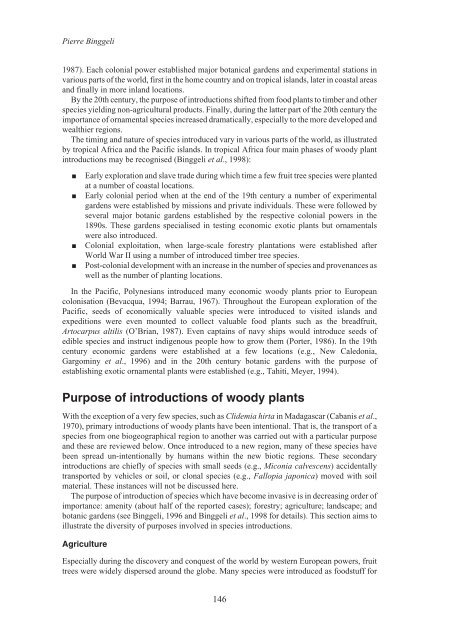Alien Species.vp - IUCN
Alien Species.vp - IUCN
Alien Species.vp - IUCN
You also want an ePaper? Increase the reach of your titles
YUMPU automatically turns print PDFs into web optimized ePapers that Google loves.
Pierre Binggeli<br />
1987). Each colonial power established major botanical gardens and experimental stations in<br />
various parts of the world, first in the home country and on tropical islands, later in coastal areas<br />
and finally in more inland locations.<br />
By the 20th century, the purpose of introductions shifted from food plants to timber and other<br />
species yielding non-agricultural products. Finally, during the latter part of the 20th century the<br />
importance of ornamental species increased dramatically, especially to the more developed and<br />
wealthier regions.<br />
The timing and nature of species introduced vary in various parts of the world, as illustrated<br />
by tropical Africa and the Pacific islands. In tropical Africa four main phases of woody plant<br />
introductions may be recognised (Binggeli et al., 1998):<br />
■ Early exploration and slave trade during which time a few fruit tree species were planted<br />
at a number of coastal locations.<br />
■ Early colonial period when at the end of the 19th century a number of experimental<br />
gardens were established by missions and private individuals. These were followed by<br />
several major botanic gardens established by the respective colonial powers in the<br />
1890s. These gardens specialised in testing economic exotic plants but ornamentals<br />
were also introduced.<br />
■ Colonial exploitation, when large-scale forestry plantations were established after<br />
World War II using a number of introduced timber tree species.<br />
■ Post-colonial development with an increase in the number of species and provenances as<br />
well as the number of planting locations.<br />
In the Pacific, Polynesians introduced many economic woody plants prior to European<br />
colonisation (Bevacqua, 1994; Barrau, 1967). Throughout the European exploration of the<br />
Pacific, seeds of economically valuable species were introduced to visited islands and<br />
expeditions were even mounted to collect valuable food plants such as the breadfruit,<br />
Artocarpus altilis (O’Brian, 1987). Even captains of navy ships would introduce seeds of<br />
edible species and instruct indigenous people how to grow them (Porter, 1986). In the 19th<br />
century economic gardens were established at a few locations (e.g., New Caledonia,<br />
Gargominy et al., 1996) and in the 20th century botanic gardens with the purpose of<br />
establishing exotic ornamental plants were established (e.g., Tahiti, Meyer, 1994).<br />
Purpose of introductions of woody plants<br />
With the exception of a very few species, such as Clidemia hirta in Madagascar (Cabanis et al.,<br />
1970), primary introductions of woody plants have been intentional. That is, the transport of a<br />
species from one biogeographical region to another was carried out with a particular purpose<br />
and these are reviewed below. Once introduced to a new region, many of these species have<br />
been spread un-intentionally by humans within the new biotic regions. These secondary<br />
introductions are chiefly of species with small seeds (e.g., Miconia calvescens) accidentally<br />
transported by vehicles or soil, or clonal species (e.g., Fallopia japonica) moved with soil<br />
material. These instances will not be discussed here.<br />
The purpose of introduction of species which have become invasive is in decreasing order of<br />
importance: amenity (about half of the reported cases); forestry; agriculture; landscape; and<br />
botanic gardens (see Binggeli, 1996 and Binggeli et al., 1998 for details). This section aims to<br />
illustrate the diversity of purposes involved in species introductions.<br />
Agriculture<br />
Especially during the discovery and conquest of the world by western European powers, fruit<br />
trees were widely dispersed around the globe. Many species were introduced as foodstuff for<br />
146












